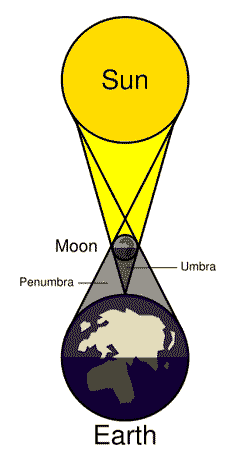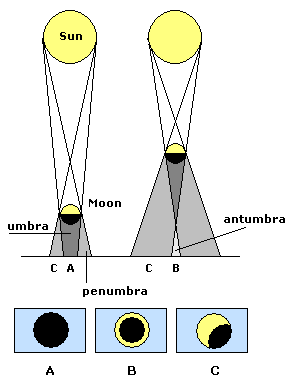|
|

|
|
|
|
ECLIPSE |
|
WEATHER |
|
TELESCOPES |
|
TOUR |
|
LINKS |
|
MAP |
GEOMETRY Diagram of solar eclipse (not to scale). The diagram shows the alignment of the Sun, Moon and Earth during a solar eclipse. The dark gray region to the right the Moon is the umbra, where the Sun is completely obscured by the Moon. The small area where the umbra touches the Earth's surface is where a total eclipse can be seen. The larger light gray area is the penumbra, in which only a partial eclipse can be seen. The Moon's orbit around the Earth is inclined at an angle of just over 5 degrees to the plane of the Earth's orbit around the Sun (the ecliptic). Because of this, at the time of a new moon, the Moon will usually pass above or below the Sun. A solar eclipse can occur only when the new moon occurs close to one of the points (known as nodes) where the Moon's orbit crosses the ecliptic. As noted above, the Moon's orbit is also elliptical. The Moon's distance from the Earth can vary by about 6% from its average value. Therefore, the Moon's apparent size varies with its distance from the Earth, and it is this effect that leads to the difference between total and annular eclipses. The distance of the Earth from the Sun also varies during the year, but this is a smaller effect. On average, the Moon appears to be slightly smaller than the Sun, so the majority (about 60%) of central eclipses are annular. It is only when the Moon is closer to the Earth than average (near its perigee) that a total eclipse occurs. The Moon orbits the Earth in approximately 27.3 days, relative to a fixed frame of reference. This is known as the sidereal month. However, during one sidereal month, the Earth has revolved part way around the Sun, making the average time between one new moon and the next longer than the sidereal month: it is approximately 29.5 days. This is known as the synodic month, and corresponds to what is commonly called the lunar month.  A Total eclipse in the umbra. B Annular eclipse in the antumbra. C Partial eclipse in the penumbra The Moon crosses from south to north of the ecliptic at its ascending node, and vice versa at its descending node. However, the nodes of the Moon's orbit are gradually moving in a retrograde motion, due to the action of the Sun's gravity on the Moon's motion, and they make a complete circuit every 18.6 years. This means that the time between each passage of the Moon through the ascending node is slightly shorter than the sidereal month. This period is called the draconic month. Finally, the Moon's perigee is moving forwards in its orbit, and makes a complete circuit in about 9 years. The time between one perigee and the next is known as the anomalistic month. The Moon's orbit intersects with the ecliptic at the two nodes that are 180 degrees apart. Therefore, the new moon occurs close to the nodes at two periods of the year approximately six months apart, and there will always be at least one solar eclipse during these periods. Sometimes the new moon occurs close enough to a node during two consecutive months. This means that in any given year, there will always be at least two solar eclipses, and there can be as many as five. However, some are visible only as partial eclipses, because the umbra passes above Earth's north or south pole, and others are central only in remote regions of the Arctic or Antarctic.
Solar eclipse. In Wikipedia, The Free Encyclopedia.
http://en.wikipedia.org/w/index.php?title=Solar_eclipse&oldid=116220081
|
|
|
||||||||||||||||||||||||
| Total Solar Eclipse of 2008 August 1st in Siberia :: Eclipse :: Weather :: Telescopes :: Tour :: Links :: Map | ||||||||||||||||||||||||||
